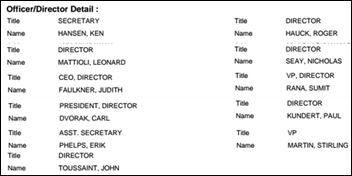Jeff Zucker is CEO and co-founder of MyDirectives of Richardson, TX.

Tell me about yourself and the company.
The company is formally known as ADVault. The AD stands for advance directive. We are singularly focused on the world of digital, emergency critical and advance care planning.
We started in 2007 and stayed in stealth mode for about five and a half years, doing a lot of research, development, and pilot testing inside hospitals and community centers and with off-the-street consumers to zero in on this fundamental challenge that’s existed for over 40 years – the desire for everyone to have an advance care plan when they need them and where doctors can find them.
We often put a lot of pressure on a very tense situation in emergency rooms by trying to get patients to create plans when it’s a little too late. That creates additional stress and strain on the patient, family, and care team that’s trying to serve them. We’re focused on giving consumers confidence that they can digitize their voice and have their advance care plan heard anywhere in the world, at any time.
While the healthcare world talks about patient-centered care, we say consumer-centered care because none of us really know when we’re going to become a patient. We want to live with confidence that, if and when we become a patient, our voice and plan can be found. That the medical teams will have some insight into our preferences, values, and care goals, and that that can contribute to a better medical experience that will value and honor the wishes of the consumer.
Our consumer-facing platform, MyDirectives.com, went live in 2012 and now has users in all 50 states and in over 30 countries just through word of mouth, the social media tree, and the health insurance and hospital ecosystem partners that have jumped on board since we started.
We went live a year ago with MyDirectives mobile, and that’s exclusively with the folks at Apple. We felt confident in the stability and the consistency of the Apple platform, and the fact that Apple let us give consumers confidence that, for example, in a cell phone environment, even if their phone was locked, they have the option to put some key information about their emergency care plan in front of the lock screen on their phone. Paramedics and ER doctors can push a button, communicate with your legal healthcare agents, and get access to your care plan. We have been very pleased with the early reaction from consumers to MyDirectives mobile.
How else have you marketed the service?
Our marketing is broad-based and multi-faceted. There’s no one way to communicate with every consumer, so we have to rely on consumers talking to other consumers. We have to rely on doctors and nurses. We use the hospital administrative ecosystem. We rely on health insurance plans to make it clear that the creation of an emergency critical advance care plan is a great way for the plan to help their beneficiaries’ voices be heard if there’s an emergency. Health plans are usually contacted by hospitals for insurance verification and it’s a great opportunity for the health plan to say, “Hey, Jeff has a plan. We suggest you go find it and use it.”
We have to bring in all the stakeholders in order to make a big change. Our view is that if this were an easy solution, it would have been done already. The problem is a 40-year-old problem. The first living will was created in 1969 and it’s been a social problem ever since. Because it’s been a problem for such a long time, it can’t be solved overnight. Our view is that we need all these stakeholders to spread the word. It’s the payers, the providers, the consumers themselves, and forward-thinking technology companies like Apple that are finding new ways to normalize a concept. We are very excited by the reaction, but recognize we have a long way to go.
How many users do you have?
The easy answer is we don’t have enough. There are 190 million people in America over the age of 18 and we want every one of them to have a plan and, more importantly, live with confidence that they won’t be a stranger if they have an accident sometime, somewhere. None of us know when we might have an accident, or where that accident will occur, and so it’s a very logical concept to say, “Responsible adults plan.” I don’t think when we went live that we expected the social tree to extend around the world as quickly as it did. We’ve tracked it and see friends and family signing up across the globe. The organic growth has been a great way for us to have a real world focus group, if you will.
How has the federal push towards greater patient engagement helped?
It’s an exciting time to be in the digital health space. We’re at the convergence of a consumer-driven digital world and a healthcare public policy world that’s forced into reform and innovation. We’re at the intersection of the two with a very important voice, the voice of the consumer.
Regardless of the administration in power, I think all of our elected leaders and the administration that supports them have realized that the more meaningful the healthcare experience, the better the outcome. The government has created some ways, some of them better than others, to try to encourage a very slow-moving industry to adopt innovative healthcare technology much more swiftly.
The federal government’s been great at pushing that. As with most things, the government responds to advances in the private sector, and then the private sector responds to advances in the legislative world. The combination, the iterative parallel processing of the two, is incredibly important and we’re very excited about what we’re seeing in 2016 and what we hope to see in the next few years. The Meaningful Use rules, specifically, have been very good at focusing attention and opening people’s minds to the fact that there might be a better way to do something.
How have providers reacted?
The providers that we have talked to, as you would expect, fall along a continuum. No one hospital moves in lockstep. They’re made up of great people with varied backgrounds. Some of them adopt innovation faster than others and so every organization has a challenge to move at a pace. The fact is that, because this is the only thing that we do as a company, we are crystal clear and incredibly focused on some very simple concepts. Every consumer deserves to live with confidence they can have their voice heard if they have an emergency, and most people don’t have a problem with that statement.
If you don’t have a problem with that statement, then the question becomes, how do you go about giving every consumer confidence that in your particular hospital, or the 15 million beneficiaries in your particular health insurance plan, or the 300,000 employees at your company that have self-funded insurance, how does your population live with confidence that they can get their voice heard?
We use technology to solve that problem. We don’t go into a room and force technology on people and say take it or leave it. We go into a room and explain that we have this human interest goal to enable people to live with confidence that they won’t be a stranger, to get rid of that fear that somehow they’re going to get sucked into a system and someone else is going to make decisions for them and they’re going to lose control in an emergency. We know that the number of people that are admitted into hospitals that have a degree of impairment in decision-making capabilities is significant. The inability to communicate or understand creates a situation where mistakes can be made, confusion can be had, and people aren’t on the same page. We know that’s not efficient. It’s also just not great outcomes.
How does your technology integrate with EHRs?
We have a variety of different integration protocols that a hospital can use to touch our database to find the digital care plan a person may have created in advance. If the person has created it, we digitally send a secure link that is populated into the EHR for that hospital.
There are a variety of integration paths that conform to global standards that hospitals can choose from. We don’t tell them what to do, obviously. We are ubiquitous. We don’t really care what EHR platform they’re on and we don’t care which integration method they use. We’re very intently focused in making sure that we don’t burden the EHR platforms. They’ve got way too many things to do as it is, so we take on that work for ourselves. We are the only MU-certified advance care planning module certified to be in an EHR.
Our singular goal is that hospitals have access to the plans created by consumers and that they open them, access them, and use them in a way that respects the preferences, values, and care goals of that consumer. If the person doesn’t have an advance care plan, then we offer hospitals the opportunity to use our system to help consumers create them. Instead of the labor-intensive process and the costly process of counseling and advising people on site in a stressful situation, we can email them or text them a link and they can create it at home. One of our advisors, former Senate majority leader Bill Frist, MD — who as a cardiologist has seen lots of trauma around the world — perhaps put it best when he said, “These issues are kitchen table issues more than they’re operating table issues.”
How does your technology stand up against the typical complaint about advance directives; i.e. that nobody in the hospital knows about them and the family doesn’t know where they’re kept?
Those complaints are real. The research on advance directives and the problems with advance directives have been very well documented and they’re multi-faceted. We’re very proud of the fact that the HIS world and the digital technology world has, in the case of emergency critical and advance care planning, allowed us to bring a solution to market that’s not just the digitization of a paper form. So much of the early wave of the Internet was, let’s just cut down the bricks and mortar and do online the stuff that we did and we’ll scale it faster. That wasn’t enough for us. The entire experience needed to be recreated. The entire context in which you asked it needed to be recreated. Our solution has innovation in not just technology, not just the clinical experience, not just in marketing, not just in the family experience, but in all those areas.
We recognize that people in the paper-based world have challenges with paper-based documents. We encourage them to try the digital experience, and if they think their paper-based document is better, keep it. We want everyone to live with confidence that their voice can be heard, so we’re thrilled if you’ve got a paper-based document that you love and can be easily accessed. We’ll even help you. You can attach it to a digital account in our system and we’ll do our best to help get that into the hands of the hospital if they need it.
We encourage you to try to answer our questions and personalize it with some video messages. It will help others know that it’s you that did it, that you were in your right mind and you weren’t under stress. That you were clearly acknowledging that these were your preferences, values, and goals of care, and these are the people that you want to speak for you. The digital world gives us time- and date-stamping opportunities and markers so that there’s no question of when you made your wishes known. It’s a much more clear and convincing process.
What will the next five years hold for the company?
In the near future, our strategy continues to be focused and simple — to make sure the technology we’ve already deployed is safe and secure, meeting or exceeding the expectations we’ve put on our hospital and consumer partners. We’re trying to raise the bar even more and excite the consumer marketplace with even more fun features that will give them the confidence that their emergency critical advance care plan is a thorough and accurate reflection of their preferences, values, and goals.
We work very hard to add hospitals and do that in conjunction with the HIEs, ACOs, and EHR platforms that serve them. We are aggressively working to integrate into the healthcare system so that providers can pull the plan if the consumer can’t push it.
With all of the innovation that’s happened in the last few years in healthcare as a whole, and the phenomenal success that cloud computing has brought to innovation in healthcare, it’s amazing to me to even start to think about what healthcare will look like three to five years from now. The cloud, for example, was around in a lot of industries before it hit healthcare. We’ve been at the forefront of the effort to try to push comfort in healthcare with cloud technology, especially with regard to its safety and security. There’s got to be efficacy around the information and the data that we share, and complete transparency to the consumer so that they know they’re in charge of their plan.
It’s important for us that the cloud continue to succeed and grow, and help normalize behavior in healthcare so that we don’t go through the expensive process of siloing data, replicating in hundreds of places the same information, which creates versioning problems, unnecessary paperwork and regulations, and wastes the time of doctors and nurses. We’re trying to make things easier and if we continue to focus on the fact that what we are doing helps ensure that a consumer’s voice can be heard if they have an emergency, then everything else becomes pretty clear.
Do you have any final thoughts?
We continue to challenge the leaders in healthcare that use the phrase “patient -entered healthcare” to back it up with the rules, regulations, policies, procedures, and workflows that reinforce that. It is fundamentally important that we practice what we preach. If we truly care about the voice of the consumer, then we have to do everything we possibly can to make sure that we’re hearing that voice, that we’re asking people to digitize that voice well in advance, because obviously the most chaotic part of the healthcare continuum is when you’re in an emergency situation where you probably can’t communicate.
Have we done anything in society to make sure that the Terri Schiavo situation can’t happen again? We don’t think society has done enough to make sure that experience doesn’t happen again. We can ensure that experience can’t happen again if we have confidence that every decision-making adult has created a plan, shared it, updated it, and verified it. We trust the medical community to take that information and create the treatment plans and protocols to meet those goals. The Terri Schiavo situation was terrible for everyone involved, but the only person who never had an opinion they could express about it was Terri herself. We’re not so focused on what her outcome was or wasn’t. We’re focused on the fact that she didn’t get her voice heard and it was her life.
Whether you have a car accident and you’re in the hospital for a couple of days and just want to go home sooner, or you’re in a chronic situation, or you’ve been recently diagnosed with something that’s incredibly serious, or you have an accident … we should not live in fear that somehow we’re going to lose control of our care.
Comments Off on HIStalk Interviews Jeff Zucker, CEO, MyDirectives

















































































Re: Dr Z. Great story, but whatever happened to professional courtesy???